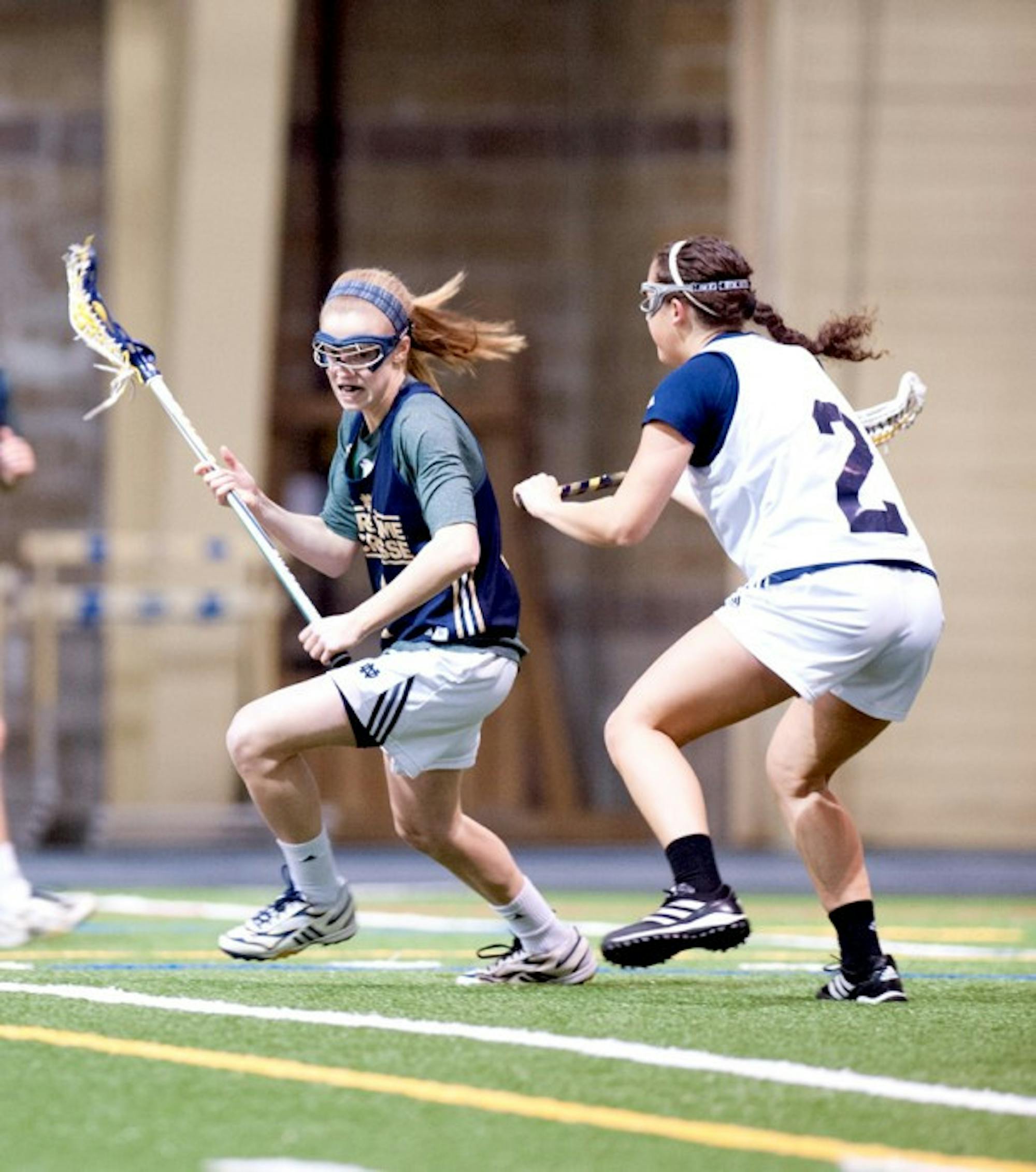Behind a young offensive core, No. 14 Notre Dame battled through a tough schedule and a rough start to its new ACC membership to earn its third straight NCAA tournament berth.
The Irish (10-9, 2-5 ACC) had their worst record since missing the NCAA tournament in 2011, the season before Christine Halfpenny took over as Notre Dame’s coach. Despite that, the Irish were able to regain their top-10 ranking and secure the right to host the first two rounds of the NCAA tournament at Arlotta Stadium, mostly due to their strength of schedule, second toughest in the nation. The Irish played 12 games against top-25 opponents in 2014, including matchups against No. 6 Boston College, No. 5 Northwestern, No. 3 North Carolina, No. 2 Maryland and two matchups against No. 1 Syracuse.
“Playing one of the hardest schedules game-in and game-out really … increased our IQ,” Halfpenny said. “Our ability to grow quickly, mature quickly and to rise to the occasion were the main benefits of playing the best schedule in the country. We’re really excited about how battle-tested we are and how we came out of that gauntlet.”
The ACC gave the Irish a challenge in their inaugural season, as over half of Notre Dame’s losses came in conference play. The addition of Notre Dame and Syracuse from the Big East gave the ACC seven out of the top 15 teams in the country, including the Irish.
Going against top teams every week was an adjustment, Halfpenny said, but the transition was made easier thanks to Notre Dame’s fast-paced style of play.
“It was a brand new year for us, a brand new conference” Halfpenny said. “I think that, fortunately, our style of play was very similar to most of the ACC teams already. Playing a fast, aggressive style of lacrosse was absolutely something that was very similar to the style in the ACC. We’ve been working that style of play since I got here, so … that was already something we didn’t have to worry about.”
Notre Dame’s aggression was apparent in its turnover statistics, as the team led the ACC in turnovers caused per game with 9.76, yet it also fared worst in the conference with 14.88 turnovers of its own per game.
This season, the Irish relied heavily on freshmen and sophomores to drive their offense. Four of their top five scorers were first or second-year players, including leading scorer freshman midfielder Cortney Fortunato. Fortunato, along with fellow freshman midfielders Casey Pearsall and Alex Dalton, started every game in her debut season for the Irish. Another freshman, goalkeeper Liz O’Sullivan, stepped up late in the season, taking over as starting goalkeeper after original starter junior Allie Murray struggled in an 18-10 loss to Syracuse on April 19.
Several sophomores also improved upon their freshman campaigns. Attacks Rachel Sexton and Kiera McMullan contributed to the offensive attack with 33 and 26 goals, respectively, good for third- and fourth-most on the squad.
Halfpenny said the level of confidence her young players exhibited throughout the season showed they wanted to leave an instant mark on the program.
“Our sophomores were able to really take what they learned last year and put that into practice,” Halfpenny said. “[The freshmen] brought a winning mentality and winning pedigree with them, and so their game plan was that we’re not waiting until our senior year to realize our potential. I’ve been incredibly impressed with the freshmen’s ability to step in, to shoulder a lot of the work during the game for 60 minutes and also how well they meshed with [the upperclassmen].”
Fortunato’s impact was immediately tangible on the field, as she led the Irish in goals with 46, ahead of junior midfielder Caitlin Gargan’s second-place total of 30. Gargan also paced the Irish in assists with 16, one fewer than Fortunato’s 17, and gave the Irish some much-needed experience as a returning starter.
Halfpenny said the impact of Notre Dame’s one-two punch went well beyond the numbers, because its greatest asset is its ability to improve and inspire the rest of the team.
[Fortunato] was massive [for our offense],” Halfpenny said. “The biggest thing is her field vision … and her creativity. Obviously you can see what she’s done in her stats, but what you might not see is the nice competition she brought to the table. Her willingness to go for it, to try new things really pushed a lot of other players into a new level of their game. [Gargan] has had a breakout junior year for us. With a very young offense out there, Caitlin was able to … establish herself as one of our veteran leaders of the offense and get the job done.”
Although the season ended with a 10-8 loss to Duke in the second round of the NCAA tournament, the Irish will return their top-six scorers and both goalies next year and will add seven incoming freshmen. Halfpenny said the team is unified in its drive to continue improving until it reaches the pinnacle of the sport.
“Our main goal is always going to be to compete for conference and national titles,” Halfpenny said. “That’s why our players choose to come to Notre Dame; it’s why I chose to come to Notre Dame. The biggest expectation I have is that we have the ability to come out here and use our God-given gifts … to establish ourselves as a premier lacrosse program that can compete for ACC and NCAA titles.”
Season Recap: Talented underclassmen impact squad
Zachary Llorens | The Observer
Sophomore attack Kiera McMullan tries to evade a Michigan defender during Notre Dame’s 19-7 exhibition win Feb. 8.









